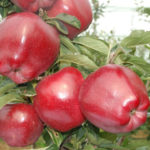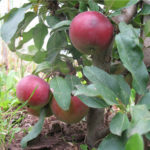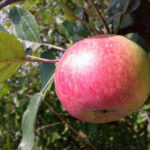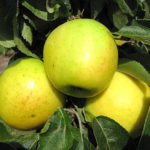Pear variety Uralochka
In the Urals, growing thermophilic pears is quite problematic. Therefore, in this region, culture is not widespread. But this fact gives breeders the opportunity to rectify the situation by creating frost-resistant pear varieties. In 1967, scientists of the South Ural Research Institute of Horticulture and Potato Growing by crossing the selected form of the Ussuri pear 41−15−9 (Limonovka Issykkulskaya x Blagoveshchenskaya) and Severyanka a new variety was obtained, which was named Uralochka. Authors: E.A. Falkenberg, M.A. Mazunin, L.I. Bolotov. The culture was introduced to the elite in 1978. In 1985, an application was submitted to conduct state tests. In 2001, the novelty was included in the State Register of Russia for the Volga-Vyatka region, it is also zoned for the Ural and West Siberian regions, and has an admission for the East Siberian region. At the moment, it is considered the most winter-hardy pear variety of the South Ural selection.

Description
The plant has an average vigor of growth, the maximum height is usually limited to 5 meters. The crown is round, spreading, not too thick. The branches that make up the skeleton are straight-growing, sparsely located, the ends are directed upward, attached to the trunk at an angle close to right. The bark covering the trunk and skeletal branches is smooth, gray in color. Shoots are slightly geniculate, rounded in cross section, not pubescent, brown. Lentils are few in number, small in size. Leaves are ordinary, green, rounded, elliptical, the apex is short-pointed, the edges are finely serrated, wavy. Leathery to the touch. The surface of the plate is smooth and shiny. The petiole is medium, thin. The flowers are standard size, pink. Fruit formations of Uralochka are fruit bags, simple and complex ringlets.
The fruits of the variety are quite small, their weight is only 44 grams, the maximum is up to 60 grams. Pears are one-dimensional, short-pear-shaped, smooth. The skin is not too thick, dull, slightly rough to the touch, dry. During the ripening period, the main color is greenish-yellow, the fruits ready for picking become golden-yellow. There is no cover color. The surface of the fruit is covered with numerous small, well-visible gray subcutaneous dots. The funnel is not deep, sharp-conical, without rusting. The calyx is half-open, not falling. The sub-cup tube is medium in length and width. The heart is bulbous, the seed chambers are closed. Seeds are round, brown, not very large. The peduncle is thin, of medium length, slightly curved, erect. The pulp has a pleasant creamy color, juicy, medium density, fine-grained consistency, medium aroma. The taste is sweet and sour, rated by tasters at 4.2 (VNIISPK) - 4.5 (State Register) points. It is necessary to harvest the fruits when they have acquired a golden color, it is at this moment that the pulp is gaining the highest possible taste. 100 grams of fresh pulp accumulates: 12% sugars, 14.8% dry matter, 0.8% organic acids, 6.5 mg vitamin C.
Characteristics
- Uralochka has a high fertility rate. Already 4 - 5 years after planting, the tree brings the first harvest;
- the ripening period of pears is late autumn. The harvest ripens on September 15 - 25;
- fruits that have reached removable maturity can last on the branches for a week or 10 days, and then they are shedding together;
- productivity is high. The yield is growing rapidly from year to year. A seven-year-old plant produces about 29 kg of fruit. The yield indicator for 4 years of testing, noted by the State Register, was 25 c / ha, which is significantly higher than the control variety. As noted by some sources, mature trees can produce up to 100 kg of fruit;
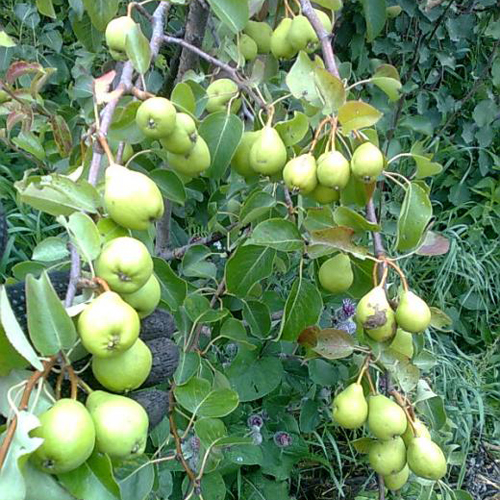
- fruiting occurs regularly, annually;
- winter hardiness of the variety is outstanding. In the unfavorable winter of 1978 - 1979, when the temperature minimum was -48.3 ° C, the mother tree froze by 1 point, young plants by 1 - 2 points. After such a winter, the trees were able to give 20 kg of harvest each;
- the flowers of our heroine are also highly resistant to spring frosts.In 1985, during the flowering period, there was a sharp decrease in temperature to -7 ° C. Uralochka turned out to be the only variety that produced a normal yield of 21.6 kg per tree. All other varieties did not bear fruit;
- high immunity is another advantage of the variety. The pear is not affected by scab, it is resistant to bacterial burns. Resists pear gall mite well (the lesion is 0.2 points);
- drought resistance is common;
- transportability is good. Shelf life is about 30 days or more;
- the way of using is universal. In addition to being consumed in its natural form, fruits can be used for processing. For example, compotes are rated at 4.2 points.
Pollinators
Our heroine has good self-fertility and is prone to setting parthenocarpic fruits. The neighborhood with Powisla, Larinska and Age-old.
Agrotechnics
The methods of caring for this variety completely coincide with the usual agricultural technology of culture in cool regions. It is recommended to use Ussuriyskaya pear as a stock. It is imperative to form a crown and further thinning and sanitary pruning.
Uralochka is an example of the fact that thermophilic fruit crops can also bear fruit perfectly in the harsh conditions of the Urals and Siberia. It is considered promising for intensive cultivation. Our heroine can be safely called a reliable variety. It has high productivity, shows stable fruiting, has a high winter hardiness of wood and resistance of flowers to spring return frosts. In addition, it has excellent immunity, is not affected by scab and actively resists other diseases and pests. High indicators of winter hardiness contributed to the active use of the variety in breeding. During the growing period, no significant shortcomings were noted. The only drawback of the pear is the insufficient weight of the fruit, but for cool regions this is a typical phenomenon.
